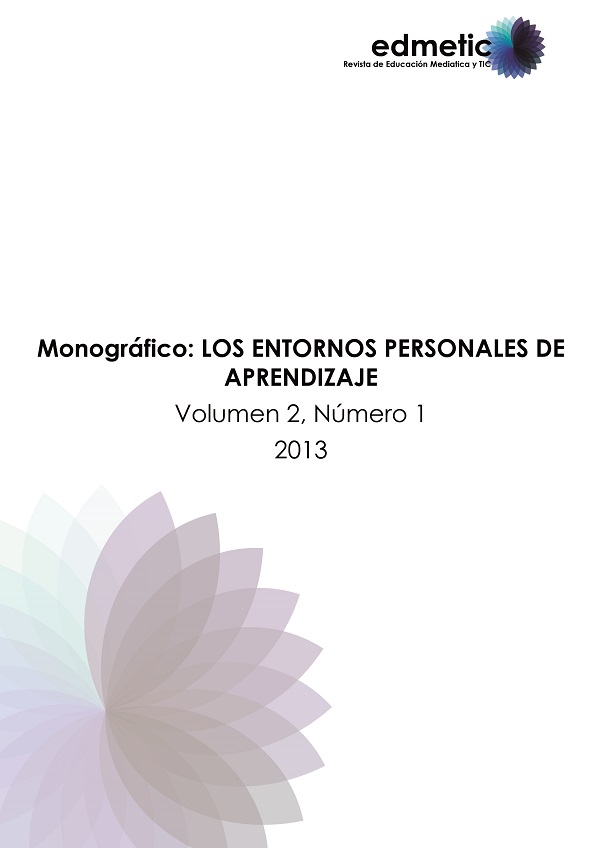Los entornos personales de aprendizaje (PLE) en la enseñanza basada en la resolución de problemas: El uso del e-portafolio
Main Article Content
Abstract
En el trabajo se busca analizar las posibilidades que nos brindan los Entornos Personales de Aprendizaje (Personal Learning Enviroment), como estrategia educativa con un gran auge en los últimos tiempos. Tras analizar su definición, buscamos la forma de relacionar el PLE con la enseñanza de las matemáticas y en especial con la resolución de problemas y el uso del E – portafolio por ser considerada una herramienta ideal para trabajar en estos entornos personales.
Downloads
Article Details
TRANSFER RIGHTS AND COMMITMENTS TO EDMETIC, REVISTA DE EDUCACIÓN MEDIÁTICA Y TIC
E-ISSN: 2254-0059
The undersigned author(s) of article entitled:
- Transfer to EDMETIC, Revista de Educación Mediática y TIC publishing rights of the article mention before. The magazine will have the right to publish in any format or media this article.
- The author(s) claim that this article is original and which has not been published before in any format and wasn´t submitted for evaluation to another publication.
- The author(s) claim that this article has the copyright´s permissions for publication
- The author(s) accept the changes to the contents on the review, and changes in the style of the manuscript by the Editorial Board of EDMETIC, Revista Educación Mediática y TIC.
- The author(s) declare that they have complied with the ethical principles of research.
- The author(s) not be subject to personal or business association that involves a conflict of interest with article presented
- El author(s) undertakes to give the primary sources of information, if requested.
Date:
Author(s) names and signatures (1):
(1) Fill the form and send to: revistaedmetic@uco.es
References
ADELL, J. y CASTAÑEDA, L. (2010). Los Entornos Personales de Aprendizaje (PLEs): una nueva manera de entender el aprendizaje. (pp. 19-30). En R. Roig y M. Fiorucci, (coords.) Claves para la investigación en innovación y calidad educativa. La integración de las Tecnologías de la Información y la comunicación y la Interculturalidad en las aulas. Alcoy: Marfil.
ARGUDÍN, M. L. (2007). Evaluación/instrumentos centrados en el alumno. Portafolio. Recuperado de: http://hadoc.azc.uam.mx/evaluacion/portafolios.htm.
ATTWELL, G. (2007). The Personal Learning environments- the future of learning? Elearning Papers, 2, (1)
BARRET, H. (2006). Using electronic Portafolios for Formative/Classroom-Based Assessment. Connected Newsletter, 13(2), 4-6. Recuperado de http://electronicportfolios.org/portfolios/ConnectedNewsletter-final.pdf.
BAUTISTA, G., BORGES, F., FORES, A. (2006). Didáctica universitaria en Entornos Virtuales de Enseñanza-Aprendizaje. Madrid: Narcea.
BROWN, J. S., Y ADLER, R. P. (2008). Minds on fire:Open education, the long tail, and learning 2.0. EDUCAUSE Review, 43(1), 16–32
CABERO, J., VÁZQUEZ, A., INFANTE, A. y SANTIESTEBAN, P. (2011). Entornos Educativos adaptados a la Web. 2.0: Entornos personales de aprendizajes. Congreso EDUTEC 2011. Recuperado en Septiembre 2012, de: http://tecnologiaedu.us.es/tecnoedu/images/stories/edutec-11d.pdf.
CASTAÑERA, L. y ADEL, J. (2011). El desarrollo profesional de los docentes en entornos personales de aprendizaje (PLE). (pp. 83-95). En R. Roig y M. Fiorucci, (coords.) Claves para la investigación en innovación y calidad educativa. La integración de las Tecnologías de la Información y la comunicación y la Interculturalidad en las aulas. Alcoy: Marfil.
CHATTI, M. A., AGUSTIAWAN, M. R., JARKE, M., y SPECHT, M. (2010). Toward a personal learning environment framework. International. Journal of Virtual and Personal Learning Environments, 1(4), 66-85.
COLL, C. y MONEREO, C. (2008). Psicología de la educación virtual. Madrid: Morata.
GARCÍA, A. (2008). Las redes sociales como herramientas para el aprendizaje colaborativo: una experiencia con Facebook. Recuperado de: http://www.mentalidadweb.com/wp-content/uploads/2008/07/comunicacion_facebook_annagarciasans.pdf.
HERNÁNDEZ, A., GONZÁLEZ, N. y GUERRA, S (2006). Diseño de un portafolio en la formación universitaria por competencias. Revista de Psicodidáctica, 11(2), 227-239.
JIMÉNEZ, J. y RICO, C. (2005) Cómo desarrollar un portafolio digital: un ejemplo práctico basado en blogs. ACTAS DEL XVI CONGRESO INTERNACIONAL DE ÁSELE, Centro Digital Cervantes. Recuperado de: http://cvc.cervantes.es/ensenanza/biblioteca_ele/asele/pdf/16/16_0758.pdf. [
LLORENTE, M (2012). Educar a través de la red. Evolución y aspectos educativos a tener en cuenta. (pp. 93-115). En E. Navas (coord.). Web 2.0 Innovación e investigación educativa. Caracas. Univ. Metropolitana.
MARCUS, R. y FEY, J. (2006) Selecting quality task for problem-based teaching. En H. Schoen y R. Charles (coords.). Teaching Mathematics through problem solving: grades 6-12. NCTM: Reston, VA.
MATEO, J. (2000). La evaluación educativa, su práctica y otras metáforas. Barcelona: ICE-Horsori.
MILLIGAN, C. (2006). The Road to the personal learning Environment. Cetis, Bolton. UK. Recuperado de http://zope.cetis.ac.uk/members/ple/resources/colinmilligan.pdf.
MORALES, P. y LANDA, V. (2004). Aprendizaje basado en problemas. Theoria, 13, 145-157. Recuperado de http://redalyc.uaemex.mx/redalyc/pdf/299/29901314.pdf.
MURILLO, G. (2012). El portafolio como instrumento clave para la evaluación en educación superior. Revista Actualidades investigativas en Educación, 12(1), 1-23.
National Council of Teachers of Mathematics. (2000). Principles and Standars for school mathematics. Reston, VA: NCTM.
OECD (2003). The PISA 2003 assessment framework. Mathematics, reading, science and problem solving knowledge and skills. Paris: OECD.
OECD (2004). Learning for tomorrow's world: First results from PISA 2003.Paris: OECD.
PUIG, Mª, DOMENE, S. y MORALES, J. A. (2007). La coherencia entre la metodología y la evaluación. Recuperado de http://redeca.uach.mx/evaluacion/La%20coherencia%20entre%20la%20metodologia%20y%20la%20evaluacion.pdf.
SALINAS, J, PÉREZ, A. y BENITO, B. (2008). Metodologías centradas en el alumno para el aprendizaje de la red. Madrid: Editorial Síntesis.
Universidad Miguel Hernández, España. (2006). El portafolio del estudiante. Recuperado de: http://www.recursoseees.uji.es/fichas/fm4.pdf .
VILLAR, L. M. (2002). La carpeta digital. (95-107). En Mª V. Aguiar, J. I. Farray y J. Brito. Cultura y Educación en la Sociedad de la Información. A Coruña: Netbiblo, SL.
